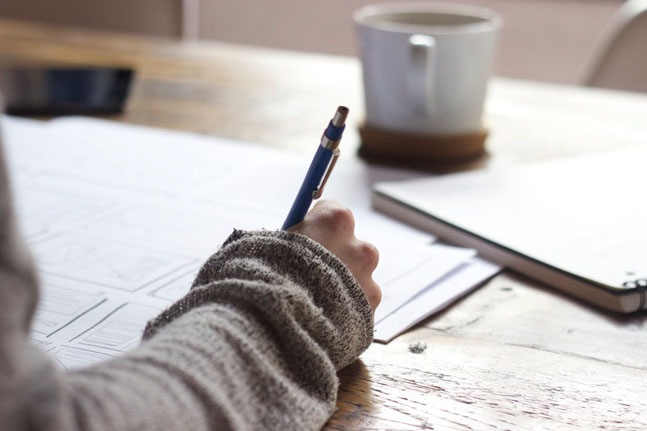Fostering stronger relationships through the art of letter writing
Yearning to slow down, be more mindful and strengthen your relationships at the same time? Dust off that pen licence and start writing. Taking the time to craft a letter to one person is the opposite of what we do when we post our thoughts to all of our social media connections. The correspondence becomes personalised and deepens the connection between two people rather than broadcasting to the masses.
Ironically, social media can take some credit for helping stage the comeback of letter writing. “The #snailmail hashtag has over 1.5 million posts on Instagram,” says Melbourne-based graphic designer and illustrator Michelle Mackintosh, the author of Snail Mail and Care Packages. She’s a self-confessed “stationery nerd” and avid letter writer.
Taking the time to craft a letter to one person is the opposite of what we do when we post our thoughts to all of our social media connections.
“In our grandparents’ era, letter writing was as important as all our social media platforms put together,” she says. “Right now, a new generation of people who love making things by hand are drawn to letter writing. Many older people still treasure a written letter, so the art of letter writing is really multigenerational.
“Awaiting a letter in the past could have been a matter of life and death, or bring great change, sadness or joy,” says Michelle. “Today they may still do a little of that; however, now that our communication channels have opened up, letters do not have the same significance. But they can still evoke strong feelings, agitate change and pull heartstrings.”
Why we write letters
Can you remember the last letter you wrote? Perhaps it was a note of thanks, an annual update to a distant relative, a rundown of your travels, birthday greetings, well wishes or maybe an apology letter. “I write for a lot of reasons, sometimes in the form of letters I take time to pretty up and other times to say thank you or for a personal reason,” says Michelle.
For Taiwan-born and New York- and Paris-based artist Lee Mingwei, writing letters has been something he has done since he was a teenager. “When I moved to San Francisco to go to high school my parents were still living in Taiwan, so I would write letters to them every week just to keep up my Chinese and the familial relationship,” says Mingwei.
When his maternal grandmother passed away when he was 18, Lee started writing letters intended for her. “I had all these things to ask her and tell her about who I am,” he says. “I was just coming out as being gay. She wasn’t there to listen to me, so I wrote her about 120 letters throughout the years.”
The letters to his grandmother formed the seed for The Letter Writing Project, an art installation first unveiled in 1998 at the Whitney Museum in New York. Having since travelled the world, the project invites participants to take their shoes off and enter the booth to write a letter.
The walls are stacked with letters, some in unsealed envelopes, others sealed. The addressed letters are posted to their destinations but Lee estimates about a third of the letters have not been addressed and therefore aren’t intended to be sent. He has also found that about half of the envelopes are left unsealed.
“Whoever chooses to leave the letter unsealed, they are inviting the next person [who enters the booth] to read it if that person chooses to,” Lee explains. “I know we are taught not to do that but there’s something quite beautiful when a stranger asks you to read something that is so intimate.
“It’s different if they leave the written letter in the booth without the envelope — when it’s put in an envelope, it’s one more step to being private.”
The imperfection of letter writing
“There’s warmth and also fragility when reading someone’s handwriting,” says Lee. “There’s something extremely intimate about that rather than just reading computer-generated text.
“If you write something and you want to erase it, you can do it; however, the mark of erasing is a real part of that conversation,” he says. “While with texting you can delete and no one will know.”
“I love the imperfection of letter writing,” says Michelle. “I have slightly odd and scrawly handwriting. I take time to loop my Ls and Hs and I cross my sevens. I write on a bit of an angle too, but I just build that into my page.”
The power of letter writing
Several years ago, Lee Mingwei discussed The Letter Writing Project at a public event at the Tate Modern in London. Afterwards a woman came up to him with a boy next to her.
“She said she had taken part in the project when it was at the Whitney,” says Lee. “She said at that time she was breaking up with her boyfriend and she wrote three pages of a very angry letter to him. However, at the end of the third page, she found the courage to forgive what he did to her, so she completed this letter with gratitude and generosity. She put it in the booth with the address on and, that night I came in, put the stamp on and sent it.”
The morning after the woman wrote her letter, Lee was contacted by the curator. “They said, ‘Sorry, Mingwei, we cannot send out this letter because the lady just called and she doesn’t want it to go out.’ But it was too late!”
“Letters can convey something incredibly important, they can gently talk about life’s small pleasures and mundanities or they can change relationships and heal old wounds.”
The woman who approached Lee at the Tate Modern told him that she was that lady, the one who had panicked about her boyfriend receiving her breakup letter. “She told me her boyfriend received the letter and was so moved by what she wrote they got back together, got married, and this boy with her was their son. I never would have imagined an artwork would have that kind of power, let alone my own artwork.”
Although he has been asked many times to publish the project’s letters in a book, Lee has turned down these offers, noting his participants’ generosity and trust in being so open. “I always feel like it’s not my place to do so,” he says. “It’s one thing to read them as they are meant to be read in The Letter Writing Project but to publish them would change and cheapen the experience.”
What to write & whom to write to
Not sure what to write about? Simply pick up your pen and see what spills forth. While big revelations may come out, don’t feel pressured to be profound. Perhaps you just want to tell your friend about a book you read or something you saw that reminded you of them.
“Letters can convey something incredibly important,” says Michelle Mackintosh. “They can gently talk about life’s small pleasures and mundanities or they can change relationships and heal old wounds.”
Got your paper and pen at the ready but unsure who to write to? While official pen pals were very popular in years gone by (particularly the 1960s and 1970s), these days most of us write to people we already know. “I write letters when a friend or colleague has been kind, or to an acquaintance who has been through something or touched me in some way,” says Michelle.
“My greengrocer just shut down so I made them some biscuits and took a card in for them to say thank you for all their wonderful service. A nurse had recently been kind to me so I left a note on my hospital bed for her when I left.”
While many of The Letter Writing Project letters were addressed to participants’ partners, parents and friends, Lee said not all intended recipients were still alive, nor human. “When the project was in Japan, there were so many letters to deceased pets,” he notes.
Travel writing
Social media is usually the place most of us share our travel adventures, but why not send a postcard or letter? You can pick up some locally made stationery or bring your own supplies. “I like to take long train rides and have a little travel pack of papers, postcards, washi tape, stickers and envelopes for making snail mail,” says Michelle.
When you’re at the post office, take a look at the stamp being affixed to your letter. Not only do they come in eye-catching designs, stamps can help you better understand the culture of the country you are in. “In Japan,” says Michelle, “the beauty of the stamp designs is enough to get anyone writing letters and postcards: seasonal fruit and vegetable themes, cute characters, anime, traditional themes.”
Crafting a beautiful-looking letter
As well as buying nice stamps, you can also dress up your envelope by adding illustrations or using washi tape (just make sure the address is still readable). Letter-writing materials and sets can be found in all kinds of different styles — or why not start with a blank piece of paper and decorate it yourself?
“A unique-looking letter is fun to put together, mostly because you can decorate a letter according to the receiver’s tastes or to a theme you both love,” says Michelle.
While she can’t leave a stationery store empty-handed, Michelle also adds her own touches to her correspondence: “I always add a few bits and pieces: origami, pressed flowers, a flyer or business card from a favourite place, maybe even a little drawing or photograph.”
Don’t worry if you’re not much of an artist. “It doesn’t need to be elaborate or laboured over,” says Michelle. “It’s the heartfelt contents that really matter; time someone has taken out of their busy day to write to you. To receive a crafted envelope and letter is an absolute joy, a jewel in your letterbox amongst bills and junk mail.”
To keep or to discard
Some people carefully store away letters they receive or display them, while others won’t mind getting rid of them, not feeling the need to hold onto them once read. You may have received a letter you want to hold onto and reread often or pass down to future generations.
“As a sender, you will never know when the letter was opened and how many times it was read or if it was shared,” says Michelle. “You won’t know if it was kept or discarded. A letter can be kept, read and reread for many years.”
As for the letters Lee Mingwei wrote to his deceased grandmother, they no longer exist. “They were private conversations between grandmother and me so on her birthday I burnt all of the letters in a ceremony for her,” he says.
To write without expectations
While you may form a pen-pal connection with someone and regularly correspond back and forth, there will be other people you write to who may not reply, so don’t get disheartened.
Just think about how you’ve potentially brightened their day and bask in the warmth of giving. “My favourite thing about writing a letter is putting it into a letterbox or leaving it on a front doorstep,” says Michelle Mackintosh.
Receiving a letter, just for you, is special. But when it comes to writing your own letters, try not to approach them simply as a means of getting something back in return. “I believe when you write a letter you shouldn’t expect a reply,” says Michelle. “It should be written with an open heart, without expectations.”








